Related Research Articles

The Hygrophoraceae are a family of fungi in the order Agaricales. Originally conceived as containing white-spored, thick-gilled agarics, including Hygrophorus and Hygrocybe species, DNA evidence has extended the limits of the family, so it now contains not only agarics, but also basidiolichens and corticioid fungi. Species are thus diverse and are variously ectomycorrhizal, lichenized, associated with mosses, or saprotrophic. The family contains 34 genera and over 1000 species. None is of any great economic importance, though fruit bodies of some Hygrocybe and Hygrophorus species are considered edible and may be collected for sale in local markets.

Hygrocybe is a genus of agarics in the family Hygrophoraceae. Called waxcaps in English, basidiocarps are often brightly coloured and have dry to waxy caps, white spores, and smooth, ringless stems. In Europe they are characteristic of old, unimproved grasslands which are a declining habitat, making many Hygrocybe species of conservation concern. Four of these waxcap-grassland species, Hygrocybe citrinovirens, H. punicea, H. spadicea, and H. splendidissima, are assessed as globally "vulnerable" on the IUCN Red List of Threatened Species. Elsewhere waxcaps are more typically found in woodlands. Most are ground-dwelling and all are believed to be biotrophs. Around 150 species are recognized worldwide. Fruit bodies of several Hygrocybe species are considered edible and are sometimes offered for sale in local markets.
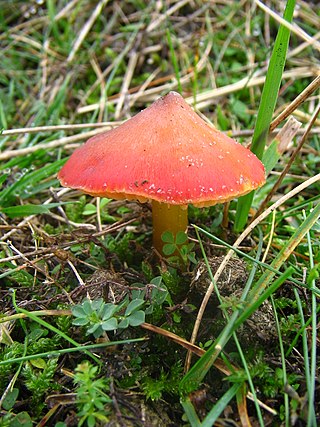
Hygrocybe conica is a species of agaric in the family Hygrophoraceae. In the UK it has been given the recommended English name of blackening waxcap, since all parts of the basidiocarp blacken with age. In North America it is commonly known as the witch's hat, conical wax cap or conical slimy cap. Hygrocybe conica is known to be a complex of at least eleven closely related species and as such is widespread in Europe, North America, Asia, and elsewhere.

Hygrocybe punicea is a species of agaric in the family Hygrophoraceae. It has been given the recommended English name of crimson waxcap. The species has a European distribution, occurring mainly in agriculturally unimproved grassland. Threats to its habitat have resulted in the species being assessed as globally "vulnerable" on the IUCN Red List of Threatened Species. Records of H. punicea from North America, East Asia, and Australia require further research to see if they represent the same species.
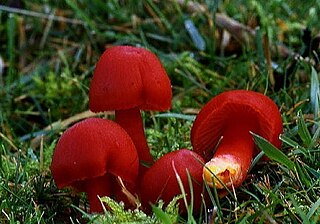
Hygrocybe coccinea, sometimes called the scarlet hood, scarlet waxcap or righteous red waxy cap, is a colourful member of the mushroom genusHygrocybe. These waxcaps are found across the Northern Hemisphere from China and Japan to Europe and North America. The small bright red mushroom is a familiar sight in unimproved grasslands in Europe in late summer and autumn, and woodlands in North America in winter.

Hygrocybe miniata, commonly known as the vermilion waxcap or miniature waxy cap, is a small, bright red or red-orange mushroom of the waxcap genus Hygrocybe. It is a cosmopolitan species, that is found worldwide. In Europe, it is found in fields, on sandy heaths, or grassy commons in the autumn. It is found in rainforest and eucalypt forest as well as heathland in Australia.

Gliophorus is a genus of agaric fungi in the family Hygrophoraceae. Gliophorus species belong to a group known as waxcaps in English, sometimes also waxy caps in North America or waxgills in New Zealand. In Europe, Gliophorus species are typical of waxcap grasslands, a declining habitat due to changing agricultural practices. As a result, two species, Gliophorus europerplexus and Gliophorus reginae, are of global conservation concern and are listed as "vulnerable" on the IUCN Red List of Threatened Species.
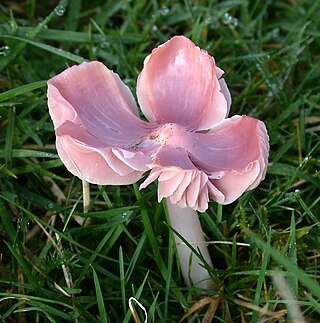
Porpolomopsis calyptriformis, commonly known as the pink wax cap, ballerina waxcap or salmon waxy cap, is a species of agaric in the family Hygrophoraceae. The species has a European distribution, occurring mainly in agriculturally unimproved grassland. Threats to its habitat have resulted in the species being assessed as globally "vulnerable" on the IUCN Red List of Threatened Species. A similar but as yet unnamed species occurs in North America.

Hygrocybe chlorophana is a species of agaric in the family Hygrophoraceae. It has been given the recommended English name of golden waxcap in the UK. The species has a largely north temperate distribution, occurring in grassland in Europe and in woodland in North America and northern Asia; it has also been reported from mountainous areas of southern Australia. It typically produces basidiocarps in the autumn. In a few European countries, H. chlorophana is of conservation concern, appearing on national red lists of threatened fungi.
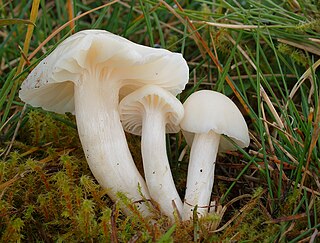
Cuphophyllus virgineus is a species of agaric in the family Hygrophoraceae. Its recommended English common name is snowy waxcap in the UK. The species has a largely north temperate distribution, occurring in grassland in Europe and in woodland in North America and northern Asia, but is also known from Australia. It typically produces basidiocarps in the autumn.

Cuphophyllus pratensis is a species of agaric in the family Hygrophoraceae. It has been given the recommended English name of meadow waxcap in the UK and in North America has variously been called the meadow waxy cap, salmon waxy cap, and butter meadowcap. The species has a widespread, mainly temperate distribution, occurring in grassland in Europe and in woodland elsewhere. The basidiocarps are edible and are occasionally collected and sold commercially.

Gliophorus irrigatus is a species of agaric in the family Hygrophoraceae. It has been given the recommended English name of slimy waxcap in the UK. The species is widespread in temperate regions, occurring in grassland in Europe and in woodland in North America and elsewhere.

Gliophorus europerplexus is a species of agaric in the family Hygrophoraceae. It has been given the recommended English name of butterscotch waxcap. The species has a European distribution, occurring mainly in agriculturally unimproved grassland. Threats to its habitat have resulted in the species being assessed as globally "vulnerable" on the IUCN Red List of Threatened Species.

Hygrocybe splendidissima, is a species of agaric in the family Hygrophoraceae. It has been given the recommended English name of Splendid Waxcap. The species has a European distribution, occurring mainly in agriculturally unimproved grassland. Threats to its habitat have resulted in the species being assessed as globally "vulnerable" on the IUCN Red List of Threatened Species.
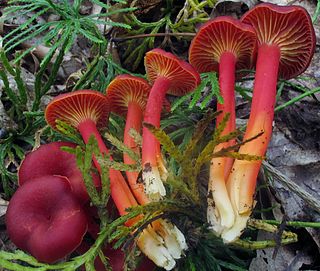
Hygrocybe appalachianensis, commonly known as the Appalachian waxy cap, is a gilled fungus of the waxcap family. It is found in the eastern United States, where it fruits singly, in groups, or clusters on the ground in deciduous and mixed forests. The species, described in 1963 from collections made in the Appalachian Mountains, was originally classified in the related genus Hygrophorus. It was transferred to Hygrocybe in 1998, in which it has been proposed as the type species of section Pseudofirmae.

Neohygrocybe ingrata is a species of agaric in the family Hygrophoraceae. It has been given the recommended English name of dingy waxcap. The species has a European distribution, occurring mainly in agriculturally unimproved grassland. Threats to its habitat have resulted in the species being assessed as globally "vulnerable" on the IUCN Red List of Threatened Species.

Hygrocybe citrinovirens is a species of agaric in the family Hygrophoraceae. It has been given the recommended English name of Citrine Waxcap. The species has a European distribution, occurring mainly in agriculturally unimproved grassland. Threats to its habitat have resulted in the species being assessed as globally "vulnerable" on the IUCN Red List of Threatened Species.
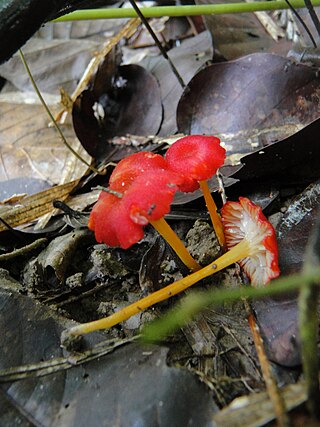
Hygrocybe umbilicata is a species of the fungal family Hygrophoraceae. This species is the first of its genus reported for Bangladesh. It was found in Singra Forest, Birganj, Dinajpur district of Bangladesh.

Neohygrocybe ovina is a species of agaric in the family Hygrophoraceae. It has been given the recommended English name of blushing waxcap, since the lamellae (gills) and flesh turn pinkish red when bruised. The species has a European distribution, occurring mainly in agriculturally unimproved grassland. Threats to its habitat have resulted in the species being assessed as globally "vulnerable" on the IUCN Red List of Threatened Species.

Hygrocybe andersonii is a species of agaric in the family Hygrophoraceae. It is sometimes referred to by common names gulfshore waxcap and clustered dune hygrocybe. The species has a North American distribution, occurring mainly on sand dune shorelines along the Gulf Coast of the United States. It was formally described and published by William Cibula and Nancy S. Weber in 1996, with the specific epithet honoring Mississippi watercolorist Walter Inglis Anderson.
References
- ↑ Kirk PM, Cannon PF, Minter DW, Stalpers JA (2008). Dictionary of the Fungi (10th ed.). Wallingford, UK: CAB International. p. 326. ISBN 978-0-85199-826-8.
- ↑ Cibula WG, Weber NS (1996). "Hygrocybe andersonii Hygrocybe andersonii a new psammophilus Hygrocybe from Horn Island, a Mississippi barrier island". Mycologia. 88 (3): 514–516. doi:10.1080/00275514.1996.12026678.
- ↑ Læssøe T, Boertmann D (2008). "A new alamellate Hygrocybe species from Ecuador". Mycological Research. 112 (10): 1206–1209. doi:10.1016/j.mycres.2008.04.002. PMID 18703325.
- ↑ Gunasekaran S, Kumaresan V, Singh S (2009). "A new species of Hygrocybe in section Firmae from Western Ghats, India". Mycotaxon. 111: 301–307. doi: 10.5248/111.301 .
- ↑ Vrinda KB, Varghese SP, Pradeep CK (2013). "Hygrocybe rubida, a new species from Kerala State, India". Mycoscience. 54 (4): 271–273. doi:10.1016/j.myc.2012.10.003.
- ↑ Hosen MI, Li TH, Aminuzzaman FM, Islam MR (2016). "Hygrocybe umbilicata sp. nov., with first generic report for Bangladesh and its phylogenetic placement". Phytotaxa. 280 (1): 070–076. doi:10.11646/phytotaxa.280.1.7.